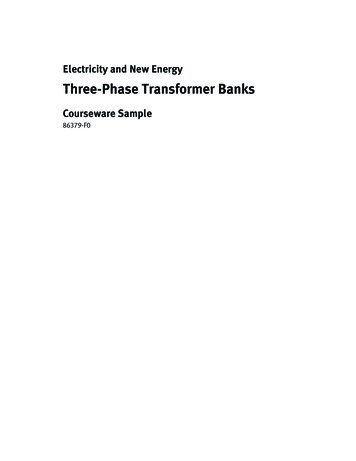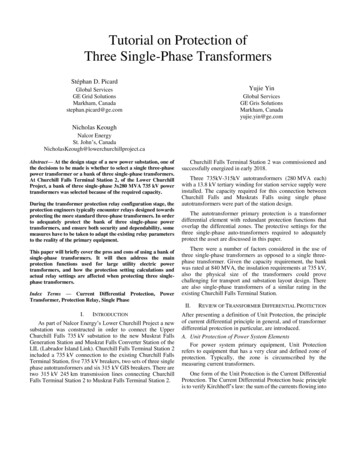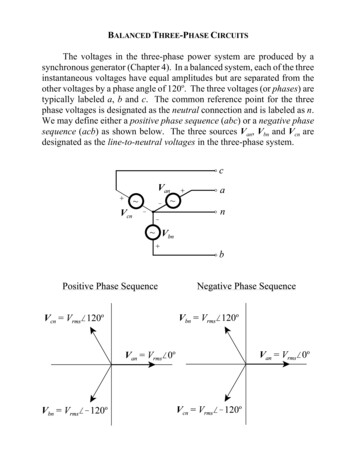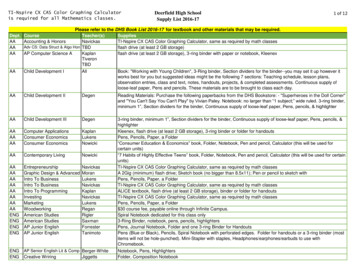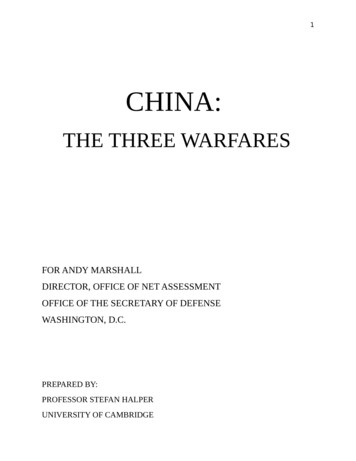
Transcription
1CHINA:THE THREE WARFARESFOR ANDY MARSHALLDIRECTOR, OFFICE OF NET ASSESSMENTOFFICE OF THE SECRETARY OF DEFENSEWASHINGTON, D.C.PREPARED BY:PROFESSOR STEFAN HALPERUNIVERSITY OF CAMBRIDGE
2MAY 2013TABLE OF CONTENTSTITLE PAGE P.6PROJECT DIRECTOR .P.7I.PROJECT ADVISERS .P.8II.ASSUMPTIONS .P.9III.EXECUTIVE SUMMARY .P.11IV.INTRODUCTION P.21V.OVERVIEW AND ANALYSIS OF THE THREE WARFARESPart 1: Definition of the Three Warfares .P.28Part 2: China and Legal Warfare .P.47Part 3: China and Media Warfare .P.71Part 4: China and Psychological Warfare .P.88Part 5: How the Three Warfares Threaten US Power Projection .P.102Part 6: China’s Vulnerabilities in Adopting the Three Warfares .P.122Part 7: Countermeasures to the Three Warfares .P.141Part 8: Linking a US Strategy of Offshore Control to the Three WarfaresCountermeasures .P.162Part 9: “The Past is Prologue”: The Situation at the Ten Year Mark .P.180VI.CONCLUSION . .P.198VII. LIST OF FIGURES . .P.225Figure 1: Key actors in the South China Sea .P.37Figure 2: China’s nine-dash U-shaped line map P.55
3Figure 3: The new Chinese passport map .P.61VIII. CONTRIBUTORS AND COMMISSIONED PAPERS . P.2261. MR. PETER MATTISChinese Propaganda and Positioning in the Sino-American Crises:The EP-3 and the Impeccable Cases. P.2262. PROFESSOR JAMES R. HOLMESOld -- But Strong --Wine in New Bottles. China’s Three Warfares . P.2463. REAR ADMIRAL MICHAEL MCDEVITT, USN (ret.)The US Pacific Command and Dealing with China’s Three Warfares P.2744. REAR ADMIRAL JAMES GOLDRICK, RAN (ret.)Paper 1. The Three Warfares in the Maritime Domain: A LookAhead .P.299Paper 2. Impeccable and Some Offshore Islands: Two Case Studies ofthe Use of China’s Three Warfares in the MaritimeDomain .P.3145. MR. TIMOTHY WALTON
4Firing First Effectively: Lessons the Chinese have drawn from theway the US enters conflict that informs their use of the ThreeWarfares . .P.3336. PROFESSOR GEOFFREY TILLChina, the “Three Warfares” and the South and East China Sea P.3817. PROFESSOR MOHAN MALIKThe South China Sea Disputes: “Empires Never Had Sovereignty” P.4128. PROFESSOR JUSTIN NANKIVELLChina’s Use of Lawfare in the South China Sea Dispute .P.4279. PROFESSOR JAMES B. L. MAYALL, FBAThe impact of nationalism on interstate conflict in the South andEast China seas: projecting its role in China, India andJapan . P.45010.PROFESSOR PHILIP TOWLEChinese Public Diplomacy .P.47111.COMMODORE UDAY BHASKAR, IN (ret.)China’s Three Warfares concept related to India and the IndianOcean Region. . .P.481
5IX.APPENDIX .P.496X.BIBLIOGRAPHY . P.518XI.LIST OF INTERVIEWEES . P.550XII. CONTRIBUTORS’ RESUMES .P.556XIII. PROJECT ADVISERS’ RESUMES . .P.562
6CHINA:THE THREE WARFARESPROJECT DIRECTOR
7This study was conceptualized, directed and written by Professor Stefan Halper.Stefan Halper is Director of American Studies in the Department of Politics andInternational Studies at the University of Cambridge. He lectures on latter 20thCentury US foreign policy, China, and contemporary international security issues. .Professor Halper holds doctorates from Oxford and Cambridge. He is a LifeFellow of Magdalene College, CambridgeStefan Halper has served four American presidents in the White House andDepartment of State. He has produced two similar analyses for the Office of NetAssessment; The Iraq War in 2005 and The Afghan End Game in 2010.DIRECTOR OF RESEARCH: Ms. Laura Jackson holds a BA (Hons)degree from the University of Oxford in Philosophy, Politics and Economics, witha specialty in International Relations. Ms. Jackson also holds a Master ofPhilosophy (MPhil) in International Relations from the University of Cambridge.She has written on China’s application of the Three Warfares in the South ChinaSea region.SPECIAL ASSISTANT TO THE PROJECT DIRECTOR FOR RESEARCH:Ms. Mariah Robinson holds a BA in Political Science from the University ofBritish Columbia, Canada. She has worked as a research assistant for Dr. S. Halperat the University of Cambridge where her research included China’s 21 st Centuryoutlook and the South China Sea (Three Warfares).I.PROJECT ADVISERS
8Admiral Walt Doran USN (ret.)Rear Admiral James Stark USN (ret.)Rear Admiral Mike McDevitt (USN, ret.)Mr. Peter MattisProfessor James B. L. Mayall, FBAProfessor Philip TowleII. CERTAIN ASSUMPTIONS HAVE GUIDED THIS PAPER:
91.The US and China share common economic and commercial interests and,together, account for half of global economic growth. Though Washingtonand Beijing have profoundly different values and perspectives in importantareas, economic cooperation can add stability and economic growth to manyparts of the world.2.China uses its economic power to exert psychological pressure on regionalstates and the global community to encourage support for its policies andobjectives.3.China is engaged in a revitalization process.4.China seeks to regain premier global status.5.Nationalism is rapidly replacing ideology in China.6.The Beijing government may not be able to contain its liberal and traditionalnationalist critics in the event of a crisis.7.China’s South and East China Sea policy is a function of domesticconditions, the need for resources and national identity.8.China seeks to diminish or rupture US regional alliances.9.China seeks to establish a PRC sphere of maritime influence and control. InStage 1, from 2000 to 2010, this entails controlling the waters within theFirst Island Chain that links Okinawa Prefecture, Taiwan and thePhilippines. In Stage 2, from 2010 to 2020, China would control waterswithin the Second Island Chain that links the Ogasawara island chain, Guam
10and Indonesia. In Stage 3, from 2020 until 2040, China would end U.S.military dominance in the Pacific and Indian Oceans.110.The Three Warfares have generated regional tensions, alienated the SouthChina Sea littoral states from Beijing, and facilitated the US “rebalancing”to the Pacific.11.The Three Warfares is used by China to project psychological pressure,publicize “legal” arguments and to assert China’s claims to resources andterritory in regions ranging from the East and South China Seas to the Poles.The Senkaku Islands and Okinawa provide cases in point.12.China is using the Senkaku Island dispute to probe US intentions, resolveand willingness to defend Japan.13.US-Indian relations are conditioned by India’s 2000 mile shared border withChina. While India is sensitive to Chinese “encirclement”, a formalUS-India alliance is not likely at this time.1Stacy A. Pedrozo. 'China's Active Defense Strategy and its Regional Impact'. Statement before the US-ChinaEconomic & SEcurity Review Commission. Council on Foreign Relations. January 27, 2011. P.2. This strategy hasbeen enunciated by various PRC leaders in different for a.
11III. EXECUTIVE SUMMARYThis study assesses a trend that may fundamentally alter the competitive positionof the United States in the South and East China Seas region. It identifies theelements of the challenge presented by China’s Three Warfares; it refines ourunderstanding of Beijing’s varied use of this concept; its potential impact on USforce projection in the South and East China Seas; lessons the Chinese have drawnfrom the way the US enters conflicts; the implications for US strategic planningand PACOM deployments in the South China Sea and the Western Pacific; itidentifies countermeasures, and considers what we may confront in the decadeahead.The endorsement of Three Warfares by the CCP Central Committee and theCentral Military Commission in 2003 reflects China’s recognition that in themodern information age nuclear weapons have proven essentially unusable andkinetic force is the preferred option in ever decreasing scenarios.Moreover,strategies centered on kinetic engagement have too often brought problematicoutcomes and “un-won” wars.The Three Warfares is a dynamic three dimensional war-fighting process thatconstitutes war by other means. Flexible and nuanced, it reflects innovation and isinformed by CCP control and direction. Importantly, for US planners, this weaponis highly deceptive. It proceeds in a dimension separate both from the well-worn“hearts and minds” paradigm and from the kinetic context in which powerprojection is normally gauged and measured by US defense analysts. The ThreeWarfares envisions results in longer time frames and its impacts are measured by
12different criteria; its goals seek to alter the strategic environment in a way thatrenders kinetic engagement irrational.If the US objective were to gain port access for the USN in a particular country, forexample, China would use the Three Warfares to adversely influence publicopinion, to exert psychological pressure (i.e. threaten boycotts) and to mount legalchallenges—all designed to render the environment inhospitable to US objectives.The Three Warfares:This paper concludes that if the object of war is to acquire resources, influenceand territory, and to project national will - China’s Three Warfares is war by othermeans. Psychological Warfare seeks to influence and/or disrupt an opponent’sdecision-making capability, to create doubts, foment anti-leadershipsentiments, to deceive opponents and to attempt to diminish the will to fightamong opponents. It employs diplomatic pressure, rumor, false narrativesand harassment to express displeasure, assert hegemony and convey threats.China’s economy is utilized to particular effect: China threatens sale of USdebt; pressures US businesses invested in China’s market; employs boycotts;restricts critical exports (rare minerals); restricts imports; threatens predatorypractices to expand market share, etc. Media Warfare (also known as public opinion warfare) is a ‘constant,on-going activity aimed at long-term influence of perceptions andattitudes’.2 It leverages all instruments that inform and influence public2Dean Cheng. ‘Winning Without Fighting: Chinese Public Opinion Warfare and the Need for a Robust AmericanResponse’. The Heritage Foundation: Backgrounder Number 2745. November 26, 2012. P.3
13opinion including films, television programs, books, the internet, and theglobal media network (particularly Xinhua and CCTV) and is undertakennationally by the PLA, locally by the People’s Armed Police and is directedagainst domestic populations in target countries. Media warfare aims to:preserve friendly morale; generate public support at home and abroad;weaken an enemy’s will to fight and alter an enemy’s situationalassessment.3 It is used to gain ‘dominance over the venue for implementingpsychological and legal warfare’. 4 Legal Warfare (or ‘lawfare’) exploits the legal system5 to achieve politicalor commercial objectives. It has a prominent role in the warfare trilogy.Lawfare has a range of applications. They range from conjuring law toinform claims to territory and resources, to employing bogus maps to‘justify’ claims.6 In a distorted application of domestic law, for example,Beijing designated the village of Sansha on the Paracel Islands, as a HainanPrefecture to extend China’s administrative writ into the South China Sea.China also uses UNCLOS provisions and other legal conventions forunintended purposes.The instruments of lawfare include: domestic legislation, internationallegislation, judicial law, legal pronouncement and law enforcement 7 -whichcan be used in combination to inform and shape ‘lawfare’ operations.3Ibid P. 4Ibid P.45See paper by Professor Justin Nankivell.6Most notably the nine-dash U-shaped line that encompasses approximately 1 million square miles of the SouthChina Sea, but also including bogus maps detailing the Indian-Chinese border and the Senkaku Islands.7See paper by Professor Justin Nankivell4
14China’s Unique View of SovereigntyChina’s concept of sovereignty is carefully considered in separate contexts becauseit lies at the root of Chinese nationalism, and, indeed, informs much of the tensionon China’s periphery. China’s notion of sovereignty arises from the political ethicof “monism” advanced by the Confucians and Legalists 475-221 BC, which deniesthat legitimate international order can rest on co-equal sovereigns.Chinaconceives of sovereignty as indivisible: ‘if one had an equal, one was notsovereign’.8The profound disconnect between China’s view of sovereignty and the concept ofsovereignty arising from Westphalia in 1648 forms the basis for China’s rejectionof the legal architecture that has managed global equities for the past 200 years.Beijing’s ire is directed, in particular, to the post World War II structures that haveregulated global affairs through the UN, the World Court, the World Bank and nowUNCLOS. Here Beijing seeks nothing less than to revise the global legal regimenand replace it with one having Chinese characteristics.Focus on the United StatesChina’s Three Warfares is designed to counter US power projection. The UnitedStates is one of four key audiences9 targeted by the campaign, as part of China’sbroader military strategy of ‘Anti-Access/Area Denial’ in the South China Sea89Christopher Ford .The Mind of Empire: China’s History and Modern Foreign Relations. 2010.P.53Others are China’s domestic audience, the global public and the South China Sea claimants.
15The US depends upon access to the maritime commons (and Japan) to anchor itsstrategic position in Asia. China seeks to curtail US power projection by settingthe terms for US access. Separate from the likely kinetic exchange on, under andabove the sea in the event of confrontation, the Three Warfares is the mechanismby which China intends to format the campaign environment to its advantage.China aims to modify regional expectations and preferences while raising doubtsabout the legitimacy of the US presence.Four scenarios illustrate ways in which the Three Warfares may threatenfuture US power projection:i.By seeking to counter the US naval presence : In locations where the USis supporting an ally or friendly government, China would employ coerciveeconomic inducements, broadcast themed attacks asserting US ‘decline’ andassert that the US security guarantee is not reliable. Beijing’s objectivewould be to diminish or rupture US ties with the South China Sea littoralstates and deter governments from providing forward basing facilities orother support.ii.By seeking to counter US surveillance operations and routine USNdeployments. China’s objections to surveillance and USN deployments inits EEZ or elsewhere in the South or East China Seas, could bringconfrontation and the clash of two deeply held principles; China’s expansiveview of sovereignty and the US commitment to Freedom of Navigation andover-flight in international air space. China will use legal warfare to advanceits restrictive interpretation of UNCLOS and question the US right to deploynaval and air units in China’s EEZ.
16iii.By facilitating China’s global reach. Resource and energy demands--andits “Malacca Dilemma”-- force China to extend its global reach. The ThreeWarfares are being used to neutralize concerns and gain support amongregional governments, business communities, and the public for China’sgrowing presence, investments and military facilities, throughout the SouthChina Sea and Indian Ocean including Gwadar in Pakistan, Hambantota inSri Lanka, the Kra Isthmus in Thailand, and at Marao Island in the Maldives.iv.By hindering a US OffShore Control Strategy. A strategy of OffshoreControl, should it be required by the US, involves the execution of a navalblockade to create a no-man’s sea between the Chinese mainland coast andthe First Island Chain. Its success relies on the cooperation of third parties:The Three Warfares would be used to condition public opinion andbusiness sentiment and to impose economic pressure on states such as thePhilippines, Indonesia, Brunei and Malaysia to inhibit governments fromproviding the facilities and support needed to service the USN operations inthe South China Sea and to deny the US a favorable regional politicalenvironment.CountermeasuresEffective countermeasures are available and are detailed in this study. Part 7 of theOverview and Analysis section details countermeasures to ‘lawfare’, psychologicalwarfare, and media or ‘information’ warfare. A partial list includes:1. Forceful legal action brought in established international venues to challengeChina’s ‘lawfare’ initiatives before the global public;2. High profile public reaffirmation of US security commitments;3. Expanded US support for various regional multilateral fora;4. Continued and regular reconnaissance missions (must include protectionagainst harassment/attack, and proper ROE to avoid EP-3 repeat);
175. Regular Freedom of Navigation exercises in the South China Sea and within6.7.8.9.the EEZ of all nations in the Region;Strengthened public diplomacy programs;Targeted investment and development efforts;Expanded military to military talks and exchanges;Increased tempo for joint naval exercises.The Japan GambitIf China’s regional policy seems opportunistic, the Three Warfares serves to secureboth regional objectives and to mobilize nationalist emotions--and at minimal cost.The Three Warfares has shown sophistication and effectiveness in the March-June2013 period regarding the Senkaku Islands and Okinawa. In the former, China hasused “legal” arguments, psychological gambits in the form of “peoples war at sea”and a global media campaign to assert that despite established law, Japan “illegallyoccupies” the Senkaku islands. China has thus put the Islands in play. Okinawamay be headed for a similar fate—but perhaps for a different purpose. FirstXinhua printed a scholarly article raising the question of Okinawa’s status. TheMOFA then refused to confirm that Okinawa belongs to Japan. Building uponanti-Japanese regional sentiment, China’s immediate objective is to put Okinawa inplay, though its long-term objectives are unclear thus demonstrating both theflexibility and deception inherent in the Three Warfares.Discussions in JapanIn discussions and interviews held in Tokyo March 2013, Japanese political,economic and Self Defense Force leaders made clear that:i.Japan will use force if necessary to defend its position in the Senkakuislands.
18ii.Attitudes toward China among the Japanese public have hardened. Over80% believe China’s aggressive actions in the East China Sea (Senkakuiii.Islands) are responsible for rising tensions.Attitudes toward North Korea have also hardened. Fear of nuclear or othermissile attacks have accelerated the deployment of anti-missile frigates andiv.destroyers around northern Japan and around major cities.Japan will expand its military capabilities at an accelerated rate by buildingv.additional frigates, destroyers, submarines and aircraft.Japanese officials believe they have a clear and reliable agreement withWashington and rely upon the US nuclear umbrella and upon the US tovi.provide conventional forces if needed. 10Officials assert the alliance anchors the US position in the region. It isvii.essential for both nations.China’s objective is to sever the US-Japan alliance, which it believes willdegrade the regional alliance system. This is thought a crucial steppreconditioning China’s restoration of regional primacy.viii. “Japanese nationalism is in check now but could become very strong, take ahard line and provoke a confrontation. The Abe cabinet must develop aneffective course of action”.11While Japan has played a limited role in resisting Chinese aggression over the pastdecade, this will likely change. Functioning as the anchor of the US presence inEast Asia and the Western Pacific, Japan will likely take a more forward posture inaddressing the China problem as the next decade unfolds.The Three Warfares is here to stay: A Difficult Challenge10Professor Stefan Halper, met with JMDF, Parliamentary leaders, the Prime Minister’s Cabinet Secretary, theMOFA, Meti and various think tank researchers in Tokyo in March 2013.11Vice Rear Admiral Yogi Koda, Tokyo, March 22, 2013
19This study describes a process that extends China’s embrace of AsymmetricalWarfare into new realm. The Three Warfares, taken individually are manageable;but taken together they do not conform to our concept of war.Our war colleges and military research traditions emphasize kinetic exchange, thepositioning and destruction of assets and metrics that measure success by kill ratiosand infrastructure destruction.US Strategic analysis addresses the centralchallenge of battle space dominance and the optimum applications of C4ISR(command, control, communications, computers, intelligence, surveillance, andreconnaissance).By adopting the Three Warfares as an offensive weapon, the Chinese have sidestepped the coda of American military science. Our institutional apparatus andintellectual traditions are focused on a different phenomenon when we speak of, orthink of, war.They have introduced a military technology which has not previously beenconsidered as such in the West. It is a military strategy, we have not engaged,analyzed, or taught—as such--at our military academies. It is a new way ofthinking about conflict that has the advantage of both obtaining the sought afterobjective and engaging the US in an asymmetrical manner that sets aside the potentbody of military science and experience that has formed our view of war. Theythus extend the notion of asymmetrical warfare into a new dimension with thequestion of “What is war?”; Can the spoils of war be obtained without fighting in2013? The answer lies in the military function of time, and how success ismeasured. The challenge is to view these concepts in new lightA modest proposal
20At present, the US government lacks an office to coordinate countermeasures tothe Three Warfares. Such personnel could, perhaps, be attached to the China Deskat the NSC. This report provides a blueprint of the issues and possible steps to betaken. An inadequate response to this challenge could well result in the US beingout-maneuvered in this vital regional space, and in fact unable to maneuver withinit, over the next decade.IV.INTRODUCTIONThis study details the various elements of the challenge presented by China’s useof the Three Warfares in the South and East China Seas; it refines ourunderstanding of Beijing’s use of this concept, its potential impact, and theimplications for US strategic planning and PACOM deployments in the SouthChina Sea. Particular attention has been given to the manner in which the ThreeWarfares may impact US power projection and the countermeasures available toUS planners. The study concludes with an analysis of what we may confront adecade from now.THE APPROACH OF THE STUDYProject TasksThe study, presented in Part VIII, addresses the DOD tasks in a series of elevenpapers.
21Task 1: Define the Three Warfares and identify the situations and locations in theEast and South China Seas and the Sea of Japan where the Three Warfares are mostlikely to be applied.Task 2: Based upon the literature and interviews analyze the perspective of presentday Chinese military officers planning the ‘pre-conflict’ module of a possiblekinetic confrontation.Task 3: Analyze how confrontations involving use of the Three Warfares havediffered to meet the specific context of each scenario in terms of politicalconditions and operational tempo.Task 4: Analyze the lessons the Chinese have taken from the way the US entersconflicts and discuss how that informs their use of the Three Warfares.Task 5: Taking past incidents as a baseline (namely, the April 2001 EP-3 and 2009USNS Impeccable incident) analyze the application and impact of the ThreeWarfares at each stage of the crisis.Task 6:Warfares.Discuss the circumstances in which Beijing has deployed the Three(These have included fishing disputes, island and boundary disputes,Law of the Sea provisions, etc.)Task 7: Examine the Three Warfares role in the ‘war of Framing Concepts’: how,and with what effect, the campaign has been used to sway world opinion; and howmodified world opinion may impact US power projection in pre-kinetic situations.Task 8: Examine China’s use of ‘lawfare’. How does China use the “law” toadvance its objectives?
22Task 9: Analyze China’s concept of sovereignty; examine the validity of its claimsbased upon history and traditional and customary use.Task 10: Analyze the impact of nationalism on interstate conflict in the South andEast China Seas: projecting its role in China, India and Japan.Task 11: India’s perspective on China in South Asia and the Indian Ocean remainscomplex; a friend but not an ally. What are India’s priorities and how should theUS view the Indian relationship?ApproachBecause the Three Warfares is a complex, interactive process, various elements ofthese tasks are considered from different perspectives in the “Overview andAnalysis” and in separate papers. They are also addressed in the conclusion. Parts1-9 of the Overview were written as “stand-alone” documents allowing readerswith particular interests easy access; readers may find some repetition here, and inthe Introduction and Conclusion, where important findings are reiterated.CaveatsThe project Advisers and Contributors have provided guidance, suggestions anddirection and have deeply influenced many of the views expressed in the Overviewand Analysis section, but time and distance have not allowed all to review the finalversion of the paper. Contributors are responsible only for the views expressed in
23their own papers. When it is said that “Contributors believe, or contributorsassert”, it is an assessment based upon conversation and the written papers, not asurvey of views. That said, the Advisers and Contributors have provided cogentand creative analysis and provided invaluable guidance in addressing this difficultproblem.The PapersThe papers on Legal Warfare (or ‘lawfare’), one of the Three Warfares, address arange of legal questions extending from China’s deeply flawed historical claims toits practice of layering legal arguments, using bogus law and using the law toadvance and structure political claims as in Sansha City the Senkakus andTaiwan.12The paper addressing the role of ‘nationalism’ as a frame for theimplementation of the Three Warfares, addresses the dynamic relations amongChina, Japan and to a lesser extent, India and how this has, in certain instances,conditioned China’s use of the Three Warfares. 13 More directed papers consideringthe Impeccable incident, the EP-3 incident and the Senkakus address the manner inwhich China has, and is deploying the Three Warfares, and what the effects havebeen.14The writers and Advisers include: US Navy admirals with operational experiencein the South China Sea and as CINCPAC. They include an Australian Admiral, aCommodore of the Indian Navy, the Editor of China Brief who served as a USgovernment China analyst; a private sector analyst; professors of military sciencefrom the US Naval War College (USNWC), the Asia-Pacific Center for SecurityStudies (APCSS) in Hawaii, a former professor of military Science at Kings12See papers by Professor Malik Mohan and Professor Justin NankivellSee paper by Professor James B. L. Mayall.14See papers by Rear Admiral Mike McDevitt USN (ret.), and Rear Admiral James Goldrick RAN (ret.)13
24College London and the Joint Command and Staff College (UK), and professors ofhistory and international studies from the University of Cambridge.AdviceThe study benefited greatly from the advice and guidance of a small group inWashington and Cambridge consisting of RADM James Stark USN (ret.), ADMWalter Doran USN (ret.), VADM Mike McDevitt USN (ret.), Mr. Peter Mattis,Professor James Mayall, FBA, (Cambridge) and Professor Philip Towle(Cambridge).InterviewsSixty-nine Interviews and discussions were conducted in Washington, the USNaval War College at Newport, R.I., London, Oxford and Cambridge in the UnitedKingdom, PACOM and APCSS in Hawaii, The Indian National MaritimeFoundation in Delhi and the Japan Maritime Self Defense Force (JMSDF), TheJapan Institute of International Affairs, National Institute of Defense Studies,Ministry of Defense, JMSDF Staff College, JMSDF Naval War College, and theSchool of Defense Sciences, National Defense Academy , Tokyo. Most interviewswere one on one. Discussions at the JMSDF Staff College, JMSDF Naval WarCollege, and the School of Defense Sciences, National Defense Academy, Tokyohad small groups of four to six persons. Transcripts of the interviews are notincluded in this report, due to added length, although careful note was made of thesubstance which has been included in the “Over view and Analysis” section. TheInterviewees are listed in PART X.
25Why is this of interest to the US government?This study casts the Three Warfares in a new light. The Three Warfares present aformidable three dimensional war- fighting process. As such, if Clausewitz remindsus that ‘war is politics by other means’ it is correct to say that the Three Warfaresconstitute war by other means.Flexible and nuanced, the Three Warfares accommodate innovation while insuringParty control and direction. This dynamic tri-part process is mutually reinforcing.It is uniquely suited to an age where success is often determined by whose storyrather than whose army wins. It arrives at a time when mass weapo
psychological and legal warfare’. 4 Legal Warfare (or ‘lawfare’) exploits the legal system5 to achieve political or commercial objectives. It has a prominent role in the warfare trilogy. Lawfare has a range of applications. They range from conjuring law to inform clai




